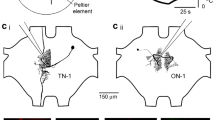Summary
Spike discharges were recorded separately from the individual slits of a lyriform organ to examine the physiological significance of the close parallel arrangement of sensory units in lyriform organs of arachnids. The organ studied lies on the posterior aspect of the spider leg tibia. It consists of 7 slits and is stimulated by induced lateral deflection of the metatarsus. According to previous model studies (Barth and Pickelmann, 1975) marked differences in the sensitivity of the individual slits were expected (Fig. 1).
-
1.
Slit 1 is the longest and a peripheral slit in the group and outstanding for its low threshold, spontaneous activity, and phasic discharge characteristics. Allother slits examined (slits 2, 3, 4, 5, and 6) respond to a sustained ramp and hold stimulus with an initial peak and a subsequent regular (power law) decline in discharge frequency before they start bursting (Fig. 2).
-
2.
Threshold stimulus amplitudes (ramp and hold stimuli, rise time 5 ms), given in degrees of metatarsal excursion, vary by a factor of nearly 90 among Slit 2 (0.01°), Slit 3 (0.11°), Slit 4 (0.42°), Slit 5 (0.65°), and Slit 6(≧0.92°) (Fig. 3).
-
3.
The stimulus amplitude ranges of the slits overlap and differ only with respect to low amplitudes. Slit 2 covers a spectrum of stimulus amplitudes of at least 45 dB (× 177). This is also the value for the entire organ not considering Slits 1 and 7 (Fig. 4).
-
4.
The stimulus response curves are saturation curves (ramp and hold stimuli; spike frequency of first 100ms). By arranging several slits to form a compound organ, the range of high increment sensitivity is enlarged as compared to the individual slit (Fig. 5).
Similar content being viewed by others
References
Barth, F.G.: Die Physiologie der Spaltsinnesorgane. II. Funktionelle Morphologie eines Mechanoreceptors. J. comp. Physiol.81, 159–186 (1972)
Barth, F.G.: Bauprinzipien und adäquater Reiz bei einem Mechanoreceptor. Verh. dtsch. Zool. Ges. Mainz66, 25–30 (1973)
Barth, F.G.: Sensory information from strains in the exoskeleton. In: The insect integument (ed. H.R. Hepburn), pp. 445–473. Amsterdam: Elsevier 1976
Barth, F.G.: Slit sense organs: “Strain gauges” in the arachnid exoskeleton. Symp. zool. Soc. Lond.42, 439–448 (1978)
Barth, F.G., Libera, W.: Ein Atlas der Spaltsinnesorgane vonCupiennius salei Keys. Chelicerata (Araneae). Z. Morph. Tiere68, 343–369 (1970)
Barth, F.G., Pickelmann, P.: Lyriform slit sense organs in spiders. Modelling an arthropod mechanoreceptor. J. comp. Physiol.103, 39–54 (1975)
Barth, F.G., Seyfarth, E.-A.: Slit sense organs and kinesthetic orientation. Z. vergl. Physiol.74, 326–328 (1971)
Barth, F.G., Stagl, J.: The slit sense organs of arachnids. A comparative study of their topography on the walking legs (Chelicerata, Arachnida). Zoomorphologie86, 1–23 (1976)
Bohnenberger, J.: On the transfer characteristics of a lyriform slit sense organ. Symp. zool. Soc. Lond.42, 449–455 (1978)
Bohnenberger, J., Barth, F.G.: Lyraförmige Spaltsinnesorgane: funktionelle Eigenschaften ihres komplexen Aufbaus. Verh. dtsch. Zool. Ges.1977, 271 (1977)
Burkhardt, D.: Die Eigenschaften und Funktionstypen der Sinnesorgane. Ergebn. Biol.22, 226–267 (1960)
Seyfarth, E.-A.: Mechanoreceptors and proprioceptive reflexes: lyriform organs in the spider leg. Symp. zool. Soc. Lond.42, 457–467 (1978a)
Seyfarth, E.-A.: Lyriform slit sense organs and muscle reflexes in the spider leg. J. comp. Physiol.125, 45–57 (1978b)
Seyfarth, E.-A., Barth, F.G.: Compound slit sense organs on the spider leg: mechanoreceptors involved in kinesthetic orientation. J. comp. Physiol.78, 176–191 (1972)
Author information
Authors and Affiliations
Additional information
Supported by a grant from the Deutsche Forschungsgemeinschaft
We thank Dr. E.-A. Seyfarth for valuable comments on the manuscript and Mrs. R. Kuhn for excellent technical assistance.
Rights and permissions
About this article
Cite this article
Barth, F.G., Bohnenberger, J. Lyriform slit sense organ: Thresholds and stimulus amplitude ranges in a multi-unit mechanoreceptor. J. Comp. Physiol. 125, 37–43 (1978). https://doi.org/10.1007/BF00656829
Accepted:
Issue Date:
DOI: https://doi.org/10.1007/BF00656829




